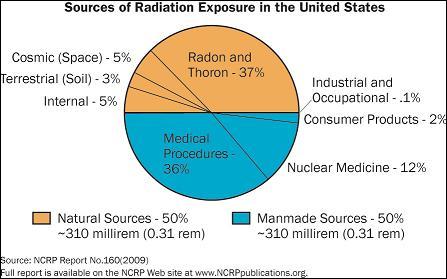In order to accurately measure radiation with a Geiger counter, we must start with the normal background radiation. Background radiation comes from both natural and man-made radioactivity. Previous posts have detailed various sources from both of these types. The actual regular background radiation varies from place to place on the surface of the Earth. It also varies with time depending on the weather, the seasons and human activities. In addition, different information sources give different standard background radiations for the same place.
Here is a chart from a Wikipedia article.
This next chart is from the US Nuclear Regulator Commission.
Converting from millirems to millisieverts at 100 to 1 yields natural sources contributing 3.1 mSv and Manmade sources contributing 3.1 mSv for a total of 6.2 mSv per year. S you can see, the quoted levels for the US vary from 2.0 mSv to 6.2 mSv.
To understand how much radiation you are exposed to in the course of a year, you must take into account more than just the background radiation where you live. You also have to include events and activities in your life.
If you smoke, it will add 2.8 mSv to your annual dose. Bear in mind that second hand smoke from being around people who smoke will also add to your annual dose. People who frequent or work in establishments which permit smoking may be getting a lot more than 2.8 mSv per year.
Altitude changes your dose because higher up, you have less atmosphere and more exposure to radiation caused by cosmic rays. Here is a table of mSv for altitudes above sea level measured in feet.
The region of the US where you live influences your exposure. to radiation. The Gulf coast exposure is .23 mSv, the Atlantic Coast exposure is .23mSv, the Colorado Plateau exposure is .90 mSv and in the rest of the US, the exposure averages .46 mSv.
Of the radiation you carry in your body, .40 mSv comes from food and water, 2 mSv comes from Radon in the air, plutonium powered pacemakers contribute 1 mSv, and porcelain crowns in your teeth add .0007 mSv.
Travel can also contribute to your annual radiation dosage. Airplane travel contributes .01 mSv per 1000 miles traveled. Airport security scanners add
If you live in a stone, brick or concrete building you will get .07 mSv from your residence. Television adds .01 mSv per year and computers add .001 mSv. Medical X-rays are .4 mSv each. Nuclear medical procedures are .14 mSv each. Living within 50 miles of a nuclear power plant will give you .00009 mSv per year and living within 50 miles of a coal fired power plant will give you .0003 mSv per year.
The above numbers come from a brochure published by the American Nuclear Society. As you can see, many factors contribute to the amount of radiation you may be exposed to in the course of a normal year.
The exposure range here of 2 mSv to 6.2 mSv translates to .23 μSv/per hour to .71 μSv/per hour, the type of readings that are typical for a Geiger counter.
